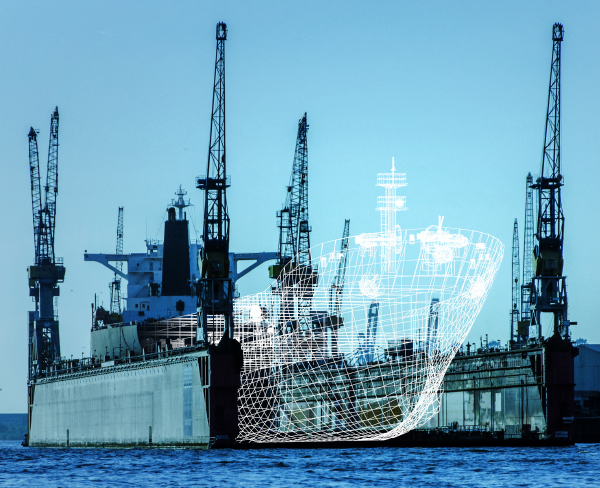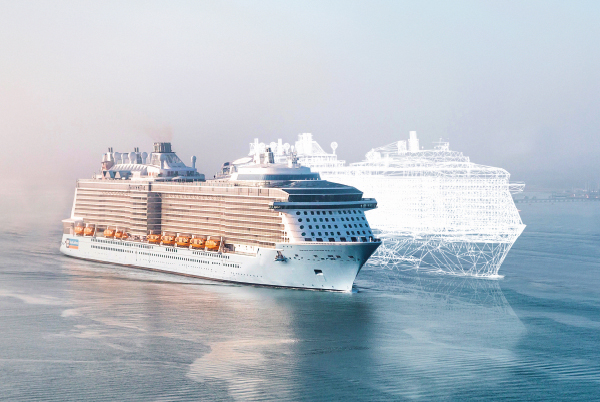
|
PROSTEP survey on the digital twin in shipbuildingBy Lars Wagner Although there is already a large number of projects involving digital twins under way in the maritime industry, there is no common industry-wide understanding of what a digital twin is and no uniform approach to implementation. These are the results of a survey on the digital twin conducted by PROSTEP among shipyards, operators, suppliers and classification societies. 
Everyone is talking about the digital twin – even in the shipbuilding industry. But is there something like an industry-wide understanding of what companies in the maritime industry mean by the term "digital twin" and what they expect from it? To find out, PROSTEP conducted a cross-enterprise survey of shipyards, operators, suppliers and classification societies. Due to the novelty of the topic, we assumed that companies have different ideas about the digital twin. The objective of the survey was to shed light on what companies in the maritime industry understand the digital twin to be, to record the status of current or planned applications and solutions with their potential and challenges, and also to see how the companies organize collaboration in the context of the digital twin. Managers from more than a dozen shipyards, operators, suppliers and classification societies, representing different sectors of the maritime industry from cruise, containers and cargo to naval engineering, navy and public agencies, were surveyed. For many of those who participated in the survey, the digital twin is at best a vision and at worst a marketing buzzword. It therefore comes as no surprise that there is no common industry-wide understanding of what a digital twin is; there are however some remarkable similarities. Almost without exception, respondents across all segments of the industry associate the digital twin with the digitalization of their product or the asset to be operated but not with the digitalization of the production systems. Almost all respondents also believe that this digital twin does not end when the product is handed over to the customer but also accompanies the operating phase. On the whole, it appears that respondents from the supplier segment have somewhat of a head start over other segments of the industry when it comes to the level of maturity of digital twin projects. Many are in the pilot stage or are already being used productively. It is also the suppliers who are calling the loudest for standards that will enable them to integrate their digital representations with other systems in the overall system that is a "vessel" and exploit the potential that the digital twin offers. The companies have different reasons for addressing the topic of the digital twin. From an engineering perspective, primary focus is placed on optimizing designs based on insights gained during operation, the early testing of functions and providing support for downstream business processes with the help of 3D product models. In the operating phase, improved planning and remote support for maintenance and inspection tasks as well as the optimization of operating parameters are key drivers for projects currently underway. Initial use cases in manufacturing include the virtual approval of work, the early training of personnel in the construction phase of a vessel, and the optimization of manufacturing processes. 
For the majority (over 70 percent) of the companies surveyed, improving service quality is the most important potential offered by the digital twin; this is followed by supporting new business models and improving the development process. As far as suppliers in particular are concerned, the main benefit is the ability to avoid subsequent costs and work resulting from development errors. For operators, on the other hand, the digital twin offers significant potential for increasing capacity utilization, reducing operating costs and improving sustainability, e.g. by reducing emissions. Increasing collaboration in the context of implementing and using digital twins is seen throughout the industry as posing the greatest challenge – along with a lack of standards and the availability of appropriate models, which are of concern to suppliers in particular. With the exception of a few suppliers, the vast majority of the manufacturing companies surveyed do not work together with partners on digital twin projects at all or do so rarely. Most operators, on the other hand, already use digital representations of their ships to optimize operation of the vessels together with partners and customers, and they access digital service and maintenance offerings from partners. 
In principle, all the companies are in favor of a higher level of collaboration when it comes to implementing and using the digital twin. Many, however, have reservations when it comes to protecting their intellectual property and see contractual ambiguities with regard to digital content. This means that every company is trying to exploit the potential of the digital twin with their own benefit in mind. There is also no uniform approach to dealing with this topic in the individual segments of the industry, and a different approach is taken for each application scenario. There is a risk that the digital twin projects will lead to the creation of new data silos. The results of the survey provide a basis for recommending action that can be taken by companies in the maritime industry. Perhaps the most important is collaborating with other companies in the context of implementing and using digital twins. Companies that actively collaborate with partners are usually able to implement their projects faster. We recommend that companies tackle concrete projects that offer economic value added. Collect the data you need for the project at hand but avoid creating new data silos by linking the data that you have collected according to clearly defined rules. The digital components for the digital twin are available in most companies in the form of models, data and IT systems. You just need to clarify how you can best exploit this potential to meet your business needs. Our many years of experience with digitalization initiatives in the shipbuilding industry means that we are in a position to help you do this. You can find more about our survey here. (English version available soon.) |
|
| © PROSTEP AG | ALL RIGHTS RESERVED | IMPRINT | PRIVACY STATEMENT | YOU CAN UNSUBSCRIBE TO THE NEWSLETTER HERE. |

